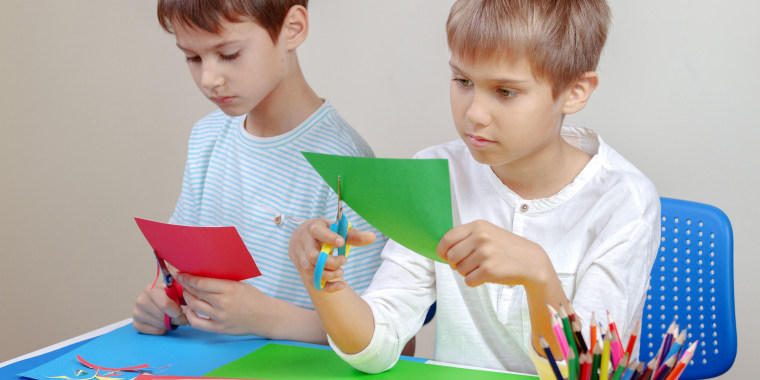By fourth grade, children are well on their way to forming the personal habits that will determine their future health and well-being. These skills will help you support your fourth-grader's physical development.
Their gross motor skills, which involve whole-body movement, are fully developed by this age, although they will continue to be refined over the next few years. The same applies to fine motor skills, which involve the coordination of small muscle movements. Children in fourth grade are usually 9 or 10 years old, and the information in this physical activity guide covers children in the typical age group. However, the age at which children reach milestones for physical growth varies considerably, especially around the onset of puberty, which can start around this time for many girls. If you are concerned that your child seems to lag behind his peers in terms of physical development, you should consult your pediatrician.
Gross motor skills
Overview
Your fourth-grader’s gross motor skills, which involve whole-body movement, should be almost fully developed by the time they are 10 years old. In early childhood their physical activity was focused largely on practicing movements and learning coordination. Now they are transitioning into building more muscle strength and developing greater coordination, balance, and stamina. These abilities are honed through activities such as throwing, catching, and hitting balls, riding a bike, and climbing on playground equipment. Physical activity at this age should include games and sports that focus on these fundamental skills. Unstructured playtime remains important, but as your child’s ability to run and jump and throw, kick and catch a ball with accuracy improves, organized sports such as baseball or soccer may be worth exploring. Other activities to consider include dance, judo and gymnastics.
Balance
Your child’s balance will continue to improve significantly throughout this year.
Movements
Your child should be able to combine different kinds of movements with ease, like jumping to catch a ball and then running with it.
Sit-ups
Your child should be able to do several sit-ups at a time.
Push-ups
Your child should be able to do several push-ups at a time, lifting only their chest off the ground.
Kick a ball
Your child should be able to kick a ball with accuracy at a target 10 to 15 feet away.
Catch a small ball
Your child should be able to catch a small ball with their hands, without holding it against their body.
Cartwheels and hand stands
Your child should be able to do cartwheels and hand stands.
Jump rope
Your child should be able to jump rope with a rope they are holding.
Fine motor skills
Overview
Your child’s fine motor skills, which involve the coordination of small muscle movements, will be nearly fully developed by the end of fourth grade, although they will continue to be refined through practice. You will see evidence of greater control and accuracy as your child performs tasks such as writing, using a keyboard, and cutting with scissors.
Write well
Your child should be able to write well by the end of fourth grade. If they have been taught to write cursive, your child should be practicing and able to print well.
Draw detailed pictures
Your child should be able to draw relatively detailed and recognizable pictures of people and animals.
Use scissors
Your child should be able to use scissors to cut along a series of curved and straight lines on a piece of paper without deviating more than half an inch from the line.
Manual dexterity
Your child should be able to complete most tasks requiring manual dexterity, such as stringing beads or fastening a clasp.
Dress and undress easily
Your child should be able to dress and undress themselves easily, and to handle snaps, buttons, zippers, and tying their shoes.
Table utensils
Your child should be able to use table utensils properly and to cut food on their plate using a knife and fork.
Sleep
Overview
Sleep is a fundamental building block for a healthy child. Well-rested children are less susceptible to viral infection, have lower rates of obesity, and perform better on their academic assignments in school. At this point in your child’s development, they have most likely internalized their nightly routine and may begin testing the boundaries of their bedtime by asking to stay up later to watch television or play video games. It is important to continue to establish clear expectations for your child and emphasize the importance of a good night’s sleep. After a restful night, your child should wake up spontaneously and have energy for the entire day. If you notice that your child is having difficulty falling asleep at night or waking up in the morning, it is important that you address these issues while they are young. Researchers have found that addressing persistent sleep problems in young children can lead to improved grades and improved mental functioning as these children reach adolescence. Consult with your child’s health care provider about additional steps you can take to ensure your child gets a more restful night of sleep.
How much sleep?
Fourth grade students need 10 to 11 hours of restful sleep every evening. Students who need to be up by 6 a.m. to get ready for school should be in bed between 7 and 8 p.m. Though this bedtime may seem unattainable to some, experts recommend making sleep a priority by encouraging your child to get as much sleep as possible. The closer they are to getting the recommended amount of sleep, the better.
Learn more about supporting your fourth-grader with our fourth grade physical health tips and physical activity recommendations pages.
TODAY's Parenting Guides resources were developed by NBC News Learn with the help of subject-matter experts, including Dr. Natasha Burgert, Pediatrician, Pediatric Associates and Dr. Jayne Greenberg, District Director, Miami-Dade County Public Schools.


